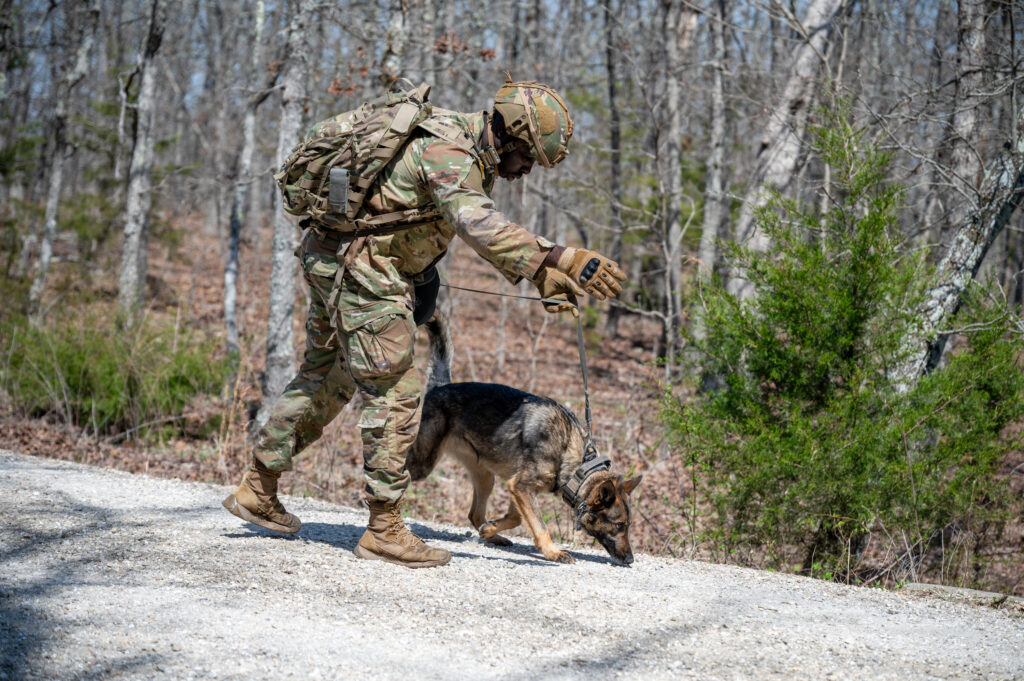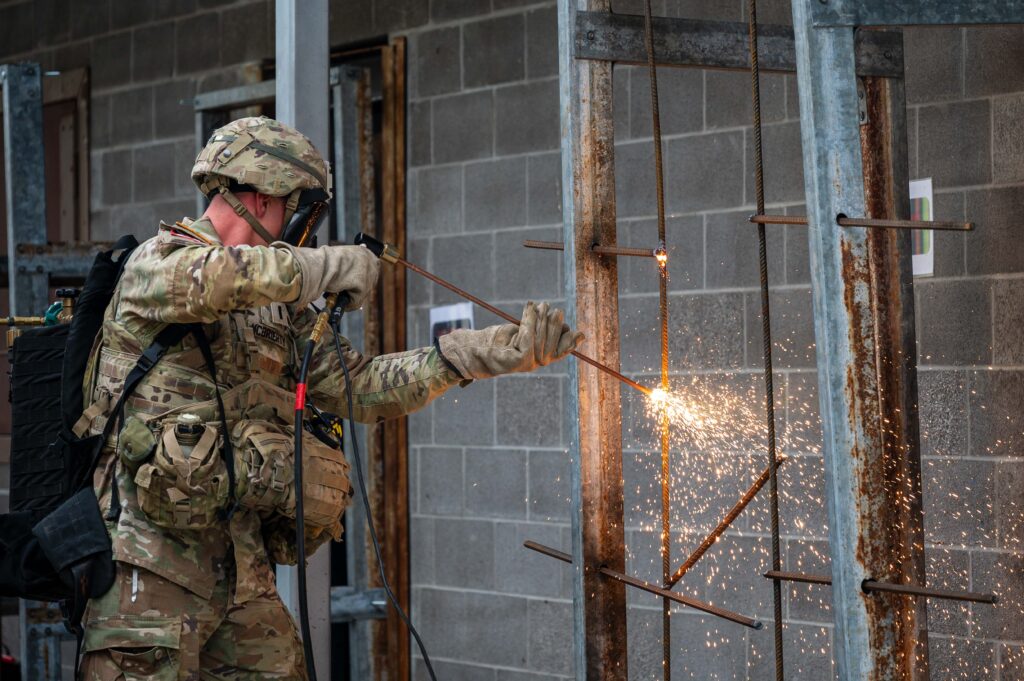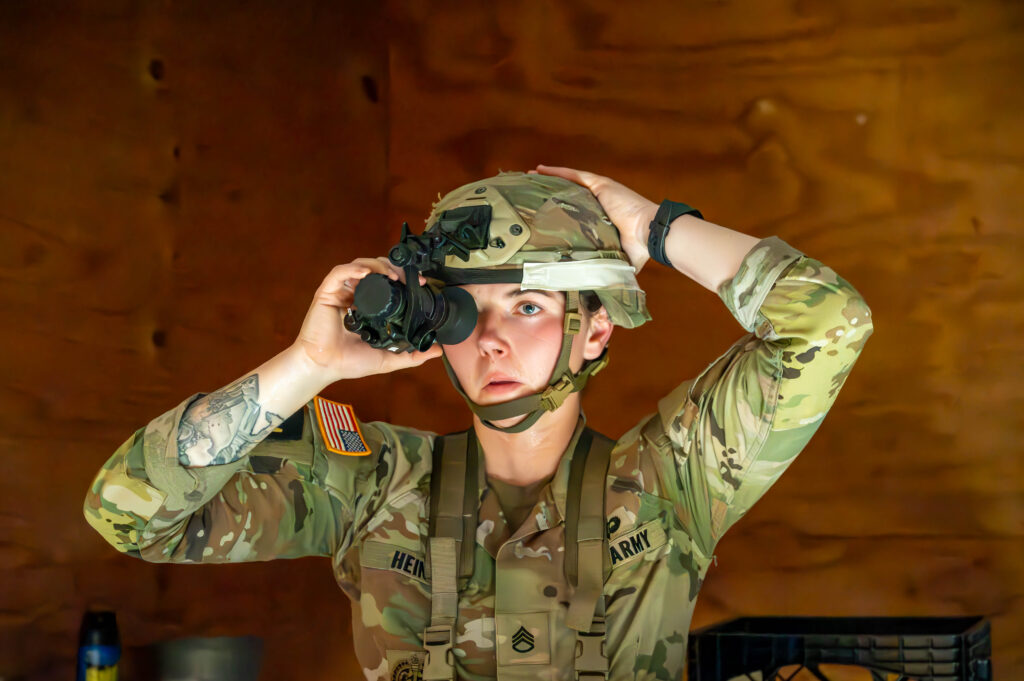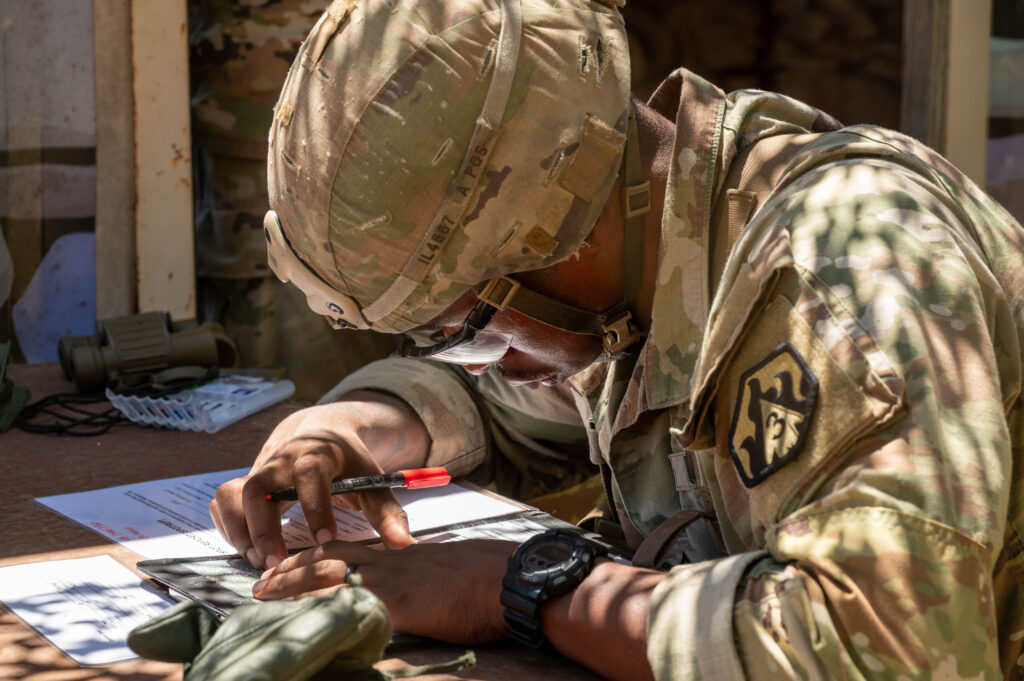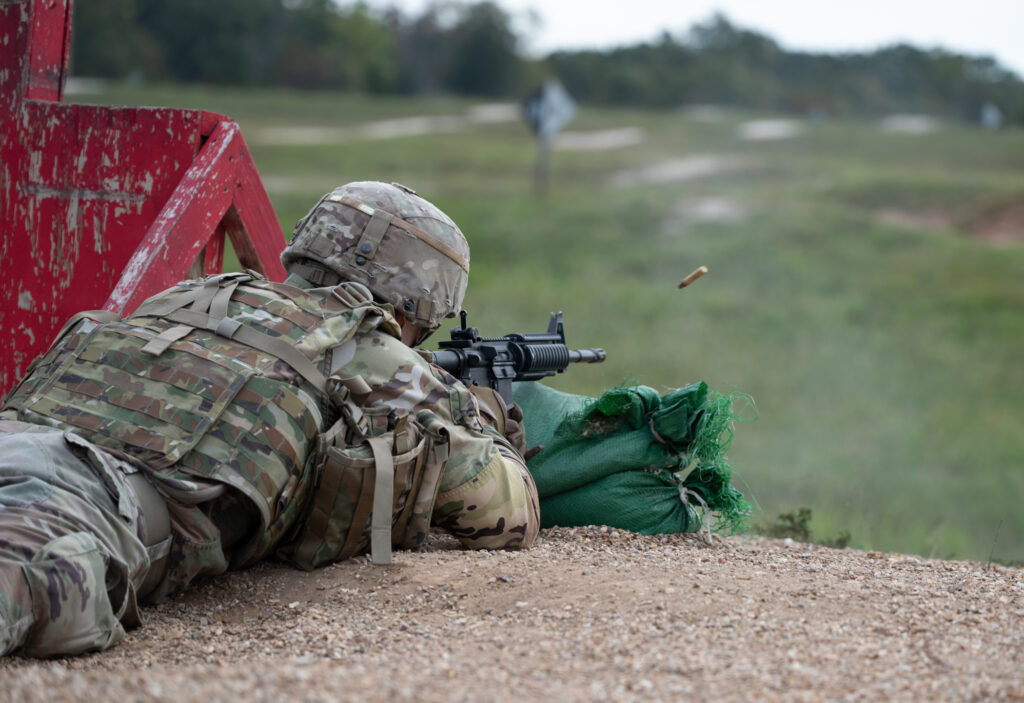Attached is this week’s eGuidon. Stories in this issue include: MSCoE Sends: The Bugle Call, Happy 245th birthday U.S. Navy, and Observing Columbus Day; ‘Into the Breach;’ Regional Health Command leaders visit post; CFC kick off; Fort Leonard Wood releases Halloween guidance; Sterile Processing Techs perform important role; and more. Stories can also be found online at myguidon.com.
Press Releases
Keeping it clean behind the scenes: Sterile Processing Technicians perform important role in Army medicine
Brian Hill
FORT LEONARD WOOD, Mo. (Oct. 9, 2020) — It’s something patients probably aren’t thinking about as they walk into General Leonard Wood Army Community Hospital or one of Fort Leonard Wood’s dental clinics, but it’s arguably one of the most important elements to Army medicine — instrument sterilization.
The technicians who perform this task every day help to ensure patient safety, and the week of Oct. 11 through 17 is designated Sterile Processing Week to recognize their efforts.
“Sterile Processing Technicians are behind the scenes in the medical and dental community, but we’re also a very crucial part of eliminating infections,” said Shirley Caracci, one of two technicians at Boak Dental Clinic. “This job requires passion, dedication, patience and precision to ensure the safety and well-being of all patients and staff.”
Caracci said patients are at risk of infections from dirty instruments used during any type of medical procedure, and the consequences can be disastrous for not only the patient, but the entire staff and the organization.
“Knowing that I play a huge role in infection prevention is very important to me,” she said.
Pamula Wilson works in GLWACH’s Sterile Processing Department. She said it’s the best job she’s ever had because she knows she makes a difference every day.
“I have so many people who count on me to do a good job,” she said. “I believe everyone who brings me their instruments to be processed has a feeling of assurance — that whatever comes up, I will do my best to make it right because I care.”
Wilson said she works with multiple clinics as well as directly with the operating rooms to clean and ensure all instrumentation is in good working condition — and available for pick up the very next day.
“It’s exciting, tense and overwhelming — you never know what kind of day you are going to have,” she said.
Once instrumentation comes down to decontamination, Wilson said she manually cleans the instruments, then places them in an ultrasonic machine, which uses waves of acoustic energy to disrupt the bonds that hold particulate matter to surfaces. After the ultrasonic, they go through a washer, followed by a check for defects, rust or debris that may have gotten through.
“We have a protein check that we also do because they can’t be seen by the naked eye,” she added. “Even though the sterilizer kills all forms of bacteria, it is worth the peace of mind you get knowing that you have done everything in your power to make patients safe.”
Wilson said most people who visit GLWACH don’t realize her department is “the hub of the facility.”
“From everything that comes into our department to everything that goes out, we are highly depended on,” she said. “We are here to take in soiled instruments and make them new again. We want our clients to feel confidence, knowing that we care for them and their patients.”
Technician Sheila Simpson at Roll Dental Clinic said she enjoys seeing “patients leave the clinic with a smile.”
“My job is extremely important, and without me doing it properly, our dental staff could not safely perform,” she said. “It gives me pride to know that I am here to help our Soldiers. In the dental field, everything begins and ends in the sterilization rooms — it’s imperative to the safety of patients and employees.”
Caracci called the sterile processing responsibilities “demanding at times.”
“The work environment is fast-paced, innovative and constantly changing — it’s never dull,” she said. “Because of this, I enjoy participating in continuing education courses to enhance my knowledge in sterile processing.”
Caracci was the catalyst for the signing in September of a proclamation by Missouri Governor Michael Parson declaring Sterile Processing Week statewide. She sent the request for the governor’s consideration.
“I thought it was important,” she said. “Proclamations honor organizations, highlight issues and causes and celebrate milestones — I felt like our work fit that criteria.”
“Sterile Processing Week recognizes the contribution Sterile Processing Technicians make to patient safety,” Parson said in his proclamation. “(They) play an important role in patient care arenas and are responsible for first-line processes to prevent patient infections.”

-30-
About Fort Leonard Wood
Fort Leonard Wood is a thriving and prosperous installation that has evolved from a small basic training post more than 75 years ago to a premier Army Center of Excellence that trains more than 80,000 military and civilians each year.
Fort Leonard Wood is home to the U.S Army Maneuver Support Center of Excellence and three U.S. Army schools: the U.S. Army Engineer School; U.S. Army Chemical, Biological, Radiological and Nuclear School; and the U.S. Army Military Police School. In addition to training engineer, CBRN and military police specialties for the Army, Fort Leonard Wood also provides gender-integrated in-processing and Basic Combat Training for new Soldiers.
Fort Leonard Wood also hosts and trains with the largest Marine Corps Detachment and Air Force Squadron on any Army installation as well as a large Navy construction detachment.
More information about Fort Leonard Wood is at: https://home.army.mil/wood/index.php/about/mission
‘Into the Breach:’ Fort Leonard Wood engineers introduce new reception and integration concept
Brian Hill
FORT LEONARD WOOD, Mo. (Oct. 8, 2020) — Nearly 200 trainees assigned to Company D, 31st Engineer Battalion, stood outside their barracks in the early dawn hours of a chilly Friday morning last week. Instead of the bag drills and shouting that usually happens early in Basic Combat Training, Sgt. 1st Class Dustin Ferguson, the company’s senior drill sergeant, calmly and succinctly explained the role of a combat engineer — the 12B military occupational specialty those trainees hoped to obtain in the near future upon successful completion of One Station Unit Training here.
“You will be the cutting edge of our country’s sword,” Ferguson said. “The skills you will possess by the end of your training are paramount to the success of our Army as a whole. As combat engineers you will, without hesitation or self-doubt, move violently ‘into the breach.’”
While Ferguson explained that phrase, the trainees watched as a squad of drill sergeants demonstrated a wire obstacle breach and attacked an enemy fighting position.
“‘Into the Breach’ is not just a term that you must know and love — it is a way of life for all combat engineers past and present,” Ferguson said. “Make no mistake about it, there is nothing pleasant about the breach. It’s often times full of chaos, mayhem, pain and suffering. However, for combat engineers, it is home.”
Ferguson described the important role combat engineers have played in infiltrating enemy lines and winning the nation’s wars.
“During World War II, combat engineers were of the first Soldiers to land on the beaches of Normandy on D-Day — June 6, 1944,” he said. “During the assault, the entire beach was covered with obstacles. A unit of combat engineers — also referred to as Sappers — had gone ahead into the breach to find where enemy mines were located. They were tasked to clear them from the battlefield while under heavy machine gun fire and mortars landing all around. They moved in pairs, if one Sapper went down his partner picked up his equipment and kept moving into battle … you could see the Sappers pulling themselves up the hillside even after their legs had been shattered by explosions.”
According to Company D Commander Capt. Jon Molnar, the trainees were being shown some of the skills they will learn — but more importantly: who they will become.
“We’re demonstrating those combat engineer skills,” Molnar said. “We’re basically showing them, ‘this is what you’re going to be able to do.’”
Following the demonstration, the trainees worked in groups to accomplish tasks related to what they had just witnessed, such as low crawling, casualty movement and building a fighting position with sand bags.
According to Molnar, the event — which is called “Into the Breach” — is modified from the new reception and integration concept to which the Army is transitioning. It replaces what was commonly referred to as “shark attacks.”
“We are tailoring it to engineer-specific skills,” Molnar added. “The goal is to foster teamwork, communication and leadership skills while still putting the trainees in a stressful, physically demanding and time-constrained environment.”
Staff Sgt. Tucker Powers, a drill sergeant assigned to Company D, was tasked with planning the events for the company. He said the goal was simple.
“It gives us purpose,” he said. “Right off the bat, the trainees get to see a demonstration of what they are hoping to achieve, and they get a little taste of what it’s going to take to get there. Our whole basis was that we wanted to give them something to strive for and have them attempt it. Every situation was mission based: there was a scenario laid out for them — ‘here’s what happened and now you have to execute.’”
Pfc. Max Morris, a trainee assigned to 1st Platoon, said he thought the event was “a real eye opener.”
“This is what we signed up for,” he said. “It was a good opportunity for us to think quick, think on our feet and develop our attention to detail. It was also good to see where we’re at physically — how much improvement is needed.”
Another 1st Platoon trainee, Pfc. Jeffrey Davids, has some perspective on the changes the Army is making. He graduated from OSUT once before while assigned to Company D, 35th Engineer Battalion, in 2005. After separating from military service more than 10 years ago, he reenlisted and finds himself back in basic training again.
“I tackled the civilian world — opened up a couple of businesses — and then found I had more to give, and here I am for a second time,” he said.
While sweat dripped from the bill of his cover, Davids said “Into the Breach” felt more purposeful than the “shark attack” as he remembered it.
“I feel like this really geared us up,” he said.
Molnar said more than simply providing a goal for the trainees, “Into the Breach” is the framework for a philosophy of mutual respect between the teachers and students.
“It promotes an attitude of trust, dignity and respect between the drill sergeants and the trainees,” he said. “It’s a teach-coach-mentor attitude — they need to work as a team to complete their collective tasks.”
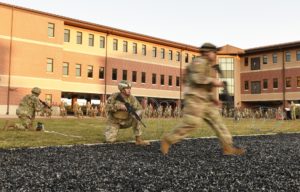
-30-
About Fort Leonard Wood
Fort Leonard Wood is a thriving and prosperous installation that has evolved from a small basic training post more than 75 years ago to a premier Army Center of Excellence that trains more than 80,000 military and civilians each year.
Fort Leonard Wood is home to the U.S Army Maneuver Support Center of Excellence and three U.S. Army schools: the U.S. Army Engineer School; U.S. Army Chemical, Biological, Radiological and Nuclear School; and the U.S. Army Military Police School. In addition to training engineer, CBRN and military police specialties for the Army, Fort Leonard Wood also provides gender-integrated in-processing and Basic Combat Training for new Soldiers.
Fort Leonard Wood also hosts and trains with the largest Marine Corps Detachment and Air Force Squadron on any Army installation as well as a large Navy construction detachment.
More information about Fort Leonard Wood is at: https://home.army.mil/wood/index.php/about/mission
Keeping engineer history alive: New print at Engineer School depicts heroic Korean War Soldiers
Brian Hill
FORT LEONARD WOOD, Mo. (Oct. 7, 2020) — Visitors to the U.S. Army Engineer School’s command section might notice a new artwork hanging on the wall — a print of a painting that depicts Soldiers on a battlefield with a bazooka and the smoking ruins of a Soviet-built, North Korean tank in the distance.
The painting, completed this year by artist Larry Selman, was inspired by real events that took place in September 1950, just a few months into the Korean War. And a closer examination of the print reveals the signature of one of the Soldiers: Pfc. Leslie Burris, an Army Engineer who is now 90 years old and lives in Rolla, Missouri. He signed five prints, one of which was presented to USAES Commandant Brig. Gen. Mark Quander in August.
Dr. Shawn Howley, USAES deputy commandant, said it’s important to highlight and document the history of the Army Engineer Regiment at the school.
“We prominently display prints like this one in highly trafficked areas in order to maximize the number of students, Soldiers and visitors who will see our heritage,” he said.
Burris was in Yongsan, South Korea, assigned to the 2nd Combat Engineer Battalion — one of thousands of Soldiers defending the Pusan perimeter after the North Korean military invaded South Korea June 25, 1950, and advanced across much of the peninsula.
He was asked one day to take a bazooka he’d never fired before and destroy a tank. So, he and a fellow Soldier, Pvt. Robert Meyers, grabbed five rockets and took off in a jeep.
According to Troy Morgan, U.S. Army Engineer Museum director, the tank was a formidable target.
“The Soviet T-34 Tank was arguably the best mass-produced tank of World War II,” Morgan said. “Throughout the summer of 1950, the North Koreans had used T-34s to punch through U.S. and Allied lines.”
Morgan, who interviewed Burris about 10 years ago, said the chances of destroying a T-34 with a bazooka were low.
“The bazooka gunner had to hit the tank in the right spot, firing at the right angle to score a disable or a kill,” he said.
After completely missing with his first shot and having to take cover from return fire, Burris scored a direct hit with his next shot and disabled the tank — only to see a second T-34 behind it. Over several hours, Burris and Meyers would ultimately destroy three T-34s.
“This was truly a David-and-Goliath fight, and there were three Goliaths,” Morgan added.
Morgan said Burris’ actions that day are more heroic than the citation for the Bronze Star he received indicates.
“The first 15 days of September resulted in a higher casualty rate among U.S. Army units than any other 15-day period of the war,” he said. “Burris and Meyers were not trained bazooka gunners. In fact, when I interviewed Burris … he stated that he had seen a bazooka fired during training but had never handled one.”
Howley said the artwork is “a welcome part of our collection.”
“One of the Engineer Commandant’s roles is to act as the keeper of our engineer history and traditions, so this print will serve to continue educating our leaders and Soldiers and inform the public of our history,” he said.
According to Army historians, the Battle of Yongsan was a five-day engagement and one of several fought simultaneously while United Nations forces attempted to maintain a presence in the southeast corner of the Korean peninsula.
By Sept. 16, 1950, U.N. forces were able to break out of the Pusan perimeter, which marked the beginning of the second of 10 named campaigns of the Korean War: U.N. Offensive 1950.


-30-
About Fort Leonard Wood
Fort Leonard Wood is a thriving and prosperous installation that has evolved from a small basic training post more than 75 years ago to a premier Army Center of Excellence that trains more than 80,000 military and civilians each year.
Fort Leonard Wood is home to the U.S Army Maneuver Support Center of Excellence and three U.S. Army schools: the U.S. Army Engineer School; U.S. Army Chemical, Biological, Radiological and Nuclear School; and the U.S. Army Military Police School. In addition to training engineer, CBRN and military police specialties for the Army, Fort Leonard Wood also provides gender-integrated in-processing and Basic Combat Training for new Soldiers.
Fort Leonard Wood also hosts and trains with the largest Marine Corps Detachment and Air Force Squadron on any Army installation as well as a large Navy construction detachment.
More information about Fort Leonard Wood is at: https://home.army.mil/wood/index.php/about/mission
14th MPs adopt Operation Hammer Drop to inspire Army’s newest Soldiers
Stephen Standifird
FORT LEONARD WOOD, Mo. (Oct. 6, 2020) — Military Police Soldiers arriving at Fort Leonard Wood for One Station Unit Training are being introduced to their chosen profession earlier in training, and Army officials said the practice is proving to be more motivational and beneficial than previous methods to welcome trainees to the Army.
The 14th Military Police Brigade calls the new event Operation Hammer Drop, which replaces the old “shark attack” method and takes place following controlled monitoring early during Red Phase training, ideally on Training Day 1. Leaders see this event as a positive alternative that will serve to motivate and inspire, and will give the new Soldiers something to look forward to in the Advanced Individual Training phase of OSUT.
Col. Robert Arnold, 14th MP Brigade commander, said Operation Hammer Drop is designed with three phases. The first is the demonstration phase, where new Soldiers are shown various aspects of MP capabilities and get to watch events like a felony traffic stop, special reaction team drill, Military Working Dogs and a tactical patrol with a medical evacuation.
“They come in to be MPs, so we want to give them something that’s inspirational,” Arnold said. “There’s going to be a wow factor. It’s motivational, it’s inspirational, it’s cool.”
The second phase is hands on and includes interactive displays of tactical and law enforcement vehicles as well as various weapons systems. For Company B, 787th MP Battalion Soldiers, there was also an opportunity to hear from CID agents and ask questions.
The third phase is team building, and each iteration so far has included different aspects with the goal of bringing the Soldiers together to learn more about each other, the MP Corps and the Army.
“With those three phases we no longer use fear — the shock and awe of what used to be the ‘shark attack,’” Arnold said. “We are now using positive, shared experiences to build more resiliency and more cohesion.”
Staff Sgt. Mario Coronado, a drill sergeant assigned to Company B, 787th MP Bn., said the positives from Operation Hammer Drop are apparent, even after only conducting one.
“This is year two for me (as a drill sergeant) and the old school Red Phase was hard core,” he said. “After actually conducting a Hammer Drop, I do think it is going to be good, because now they get to see what the MP Corps is all about before they start training.”
For two new Company B Soldiers, Operation Hammer Drop was exactly what leadership intended.
“(Operation Hammer Drop) is definitely an inspirational and motivating tool,” said Spc. Jonay Aiken. “Our training here can get a little rough sometimes, and it definitely gave me something to look forward to.”
Spc. Samantha Real said her motivation level was at a 10 because Operation Hammer Drop provided insight into what the new Soldiers will be doing as MPs.
Company B was only the fourth in the brigade to conduct an Operation Hammer Drop, but Arnold said they will continue to evolve and improve the program as more are conducted.

-30-
About Fort Leonard Wood
Fort Leonard Wood is a thriving and prosperous installation that has evolved from a small basic training post more than 75 years ago to a premier Army Center of Excellence that trains more than 80,000 military and civilians each year.
Fort Leonard Wood is home to the U.S Army Maneuver Support Center of Excellence and three U.S. Army schools: the U.S. Army Engineer School; U.S. Army Chemical, Biological, Radiological and Nuclear School; and the U.S. Army Military Police School. In addition to training engineer, CBRN and military police specialties for the Army, Fort Leonard Wood also provides gender-integrated in-processing and Basic Combat Training for new Soldiers.
Fort Leonard Wood also hosts and trains with the largest Marine Corps Detachment and Air Force Squadron on any Army installation as well as a large Navy construction detachment.
More information about Fort Leonard Wood is at: https://home.army.mil/wood/index.php/about/mission
Fire prevention educational tools available virtually
Virtual fire prevention education tools available virtually
Public Affairs
FORT LEONARD WOOD, Mo. (Oct. 5, 2020) — It’s National Fire Prevention Week and the Fort Leonard Wood Fire Department is making sure fire prevention reaches even more area children by going virtual. You can now bring fire prevention into your home and/or classroom with these great videos broken down into grade-appropriate categories.
Students K-2: https://home.army.mil/…/index…/Garrison/pao/cr/fpw/fpwk2
3rd Grade: https://home.army.mil/…/index.php/Garrison/pao/cr/fpw/fpw3
4th and 5th grades: https://home.army.mil/…/index.php/Garrison/pao/cr/fpw/fpw4
Story time: https://home.army.mil/…/index…/Garrison/pao/cr/fpw/fpwst
All categories and links can be found at https://home.army.mil/wood/index.php/Garrison/pao/cr/fpw

-30-
About Fort Leonard Wood
Fort Leonard Wood is a thriving and prosperous installation that has evolved from a small basic training post more than 75 years ago to a premier Army Center of Excellence that trains more than 80,000 military and civilians each year.
Fort Leonard Wood is home to the U.S Army Maneuver Support Center of Excellence and three U.S. Army schools: the U.S. Army Engineer School; U.S. Army Chemical, Biological, Radiological and Nuclear School; and the U.S. Army Military Police School. In addition to training engineer, CBRN and military police specialties for the Army, Fort Leonard Wood also provides gender-integrated in-processing and Basic Combat Training for new Soldiers.
Fort Leonard Wood also hosts and trains with the largest Marine Corps Detachment and Air Force Squadron on any Army installation as well as a large Navy construction detachment.
More information about Fort Leonard Wood is at: https://home.army.mil/wood/index.php/about/mission

